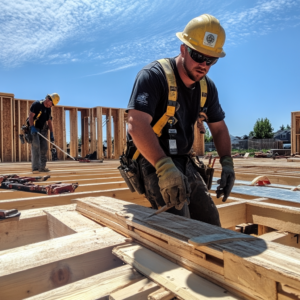Quantity takeoffs are essential in estimating costs most accurately in the construction industry. Along with setting the schedule for materials purchasing, it involves estimating the real costs of a construction project. When done correctly, the process can help teams stay on budget while optimizing workflows and preparing for worst-case scenarios.
Nevertheless, creating quantity takeoffs is a complicated process traditionally prone to error and many changes. But setting up quantity takeoffs right from the start can provide the right foundation for a successful project. In our post, we’ll discuss how businesses can improve quantity takeoffs to maximize efficiency from the very beginning of a project.
What Is a Quantity Takeoff?
First, let’s dive into the fundamentals of the preconstruction process, which typically starts when bidding begins. In a basic sense, a quantity takeoff is a list of all of the construction materials, including raw and prefabricated elements for a project; each quantity and amount of every material to be sourced is included in the list.
Takeoffs are frequently adjusted through the estimation process. This way, when the estimators set the final price for a project, they are using the most accurate information possible. With accurate estimates, contractors are more prepared to meet project budgets and timelines. Accurate estimations also reduce construction waste, which is a considerable expense for the construction industry worldwide.
Why Improve Quantity Takeoffs
Improving the quantity takeoff process for your projects can pay off significantly in the long-run. Benefits include:
- Increased Budget Certainty: For starters, improvements in takeoffs can increase budget certainty and reduce the risk of inaccurate estimates. These inaccuracies are what derail projects and cause significant cost overruns.
- Save Time: Time is a limited resource on a construction project. Having realistic and accurate takeoffs ensures a more seamless construction planning process, empowering teams to meet ambitious deadlines.
- Build Trust: Trust and communication are critical components of any project. With more accurate quantity takeoffs, a team’s rapport and confidence improve, as well as relationships with vendors and clients. This makes it easier to bridge in and work with other stakeholders on future plans.
5 Tips to Improve Quantity Takeoffs
Several essential steps can excel your efficiency and accuracy in the quantity takeoff process. Below, let’s take a look at five leading strategies to enhance takeoffs.
1. Reduce and Remove Manual Processes
The way you input data for quantity takeoffs can be a considerable barrier for efficiency. When estimators use methods like spreadsheets and Excel templates for calculating quantity takeoffs, there is a significant increase in human error and risk with inputting data. Instead, automation can help eliminate those time-consuming back-office processes involved with project planning.
When quantity takeoffs are optimized with automation, the processes are more accurate and calculated in a fraction of the time. Using technology to create digital quantity takeoffs is the easiest way to incorporate automation into the process. The right software will use details in designs and construction documents to analyze and generate a list of all materials needed. With customization options, an estimator can later go into the system and make the right adjustments, if needed.
2. Use BIM
A step beyond a pure digital takeoff is a model-based takeoff. BIM or building information modeling is another way to create more accurate quantity takeoffs. Building information modeling is defined as, “An intelligent 3D model-based process that gives architecture, engineering, and construction (AEC) professionals the insight and tools to more efficiently plan, design, construct, and manage buildings and infrastructure.” Assemble is one example of a tool that is used by teams to generate three-dimensional model-based takeoffs.
This is a great example of how Assemble users can validate traditional 2D takeoffs with Assemble in 5 easy steps:
- Publish your model to Assemble
- Organize your Assemble model inventory by Level and Category
- Switch the Assemble model viewer to orthographic mode
- Select the item(s) you want to verify (ex. Brick Vnr on 8″ CMU Wall)
- Visually validate the location of the selected items and the takeoff quantity against your 2D drawings
Right or wrong, you now have a lot more insight into the quality of information in your model and the assumptions you’ve made in your traditional takeoff process. And by the way, this whole process took a matter of minutes.
Using BIM to create takeoffs allows you to make your planning process more efficient with the most accurate visual and specification data from your project. Furthermore, teams can better address changes and alterations in a simulation rather than having to make last-minute and costly changes on the construction site.
3. Prepare for the Worst-Case Scenario to Offset
The cost of construction materials is constantly on the rise. More critically, material costs fluctuate due to everything from the weather to fuel pricing around the world. Then you also have to account for the high cost of construction waste. The cost of construction waste includes unexpected expenses like tracking, recycling, storage, and permits for managing construction waste. Quantity takeoffs that do not account for these unexpected costs in an accurate manner can derail profits and schedules.
By determining these factors and areas with the highest risk for material rises early on, you can prepare for the worst-case scenario with more precision.
4. Optimize Workflows
Larger construction projects, in particular, are more likely to have more takeoffs due to the scope of the project. Therefore, it is necessary to make improvements to your quantity takeoff workflows before scaling up.
Collaborative takeoff software is crucial to this part of the process. When you have cloud-based tools to manage takeoffs, everyone is able to work within the digital space to manage the process as one, cohesively aligned team. Through the use of the cloud, you are also able to save information in real-time even as edits are being made. This way, you speed up the time it takes to conduct meetings and make changes to documents with less chance for miscommunication errors.
5. Prioritize Integrations
If not appropriately integrated into other construction processes and tools, there is a risk of losing valuable data from the takeoffs. Aim to integrate your quantity takeoffs into as many construction processes as possible.
Start by using the latest and most successful software and technology, including BIM models. But don’t stop there. You also want to choose the right takeoff solution needs to integrate with your existing platforms and systems. This requires your teams to identify those processes that work for them now. Then you can find project management tools and other estimating programs that seamlessly integrate and complement your current systems, helping to maximize your efficiency.
Looking at the Bigger Picture
When it comes to improving quantity takeoffs on your projects, consider the broad scope of how these enhancements fit into your long term business goals. Identify how much money and time you expect to save when new processes and technology to improve the estimations. With measurable data to back up your case, you can start implementing the above processes that help set up project success from the start.




Responses